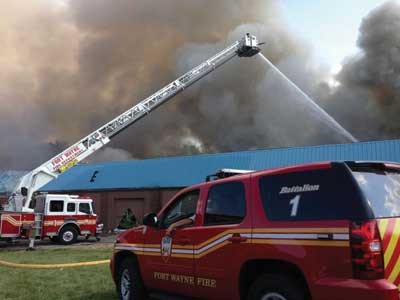BY JOHN F. “SKIP” COLEMAN, TECHNICAL EDITOR
Life was simpler when I first started fighting fires. We had four sizes of fire hose to choose from to do everything we needed to do (not including hard and soft suction hose). On the back of the engine, we had three-inch, 2½-inch, 1½-inch, and booster line. You knew you had a worker when the first-in officer told another engine company, “Lay two.” (It was a really big fire when you were told to go back to the hydrant after you laid in to “pump from the plug.”) Water was not an issue in the Toledo (OH) Department of Fire and Rescue, and water damage and water conservation because of insufficient water were almost never considerations.
When I was a young lieutenant, we had a working fire in a yacht club along the Maumee River. The first line pulled was a booster line, which apparently was not the appropriate size line to pull for the amount of fire. After the fire was out, the department took all booster lines off all front-line engines. As you can surmise, this was not the first time a booster line was pulled as an initial attack line when it should not have been.
Roundtable question: “Does your department allow a booster line to be pulled as the initial attack line at a structure fire?” To post your comments, go to fireengineering.com/roundtable.html.
 |
| PHOTO OF THE DAY: Fort Wayne (IN) Fire Department Truck 1 and Battalion 1 in the early stages of a fire in a commercial warehouse complex. (Photo by Bryan Peterson.) See more photos at http://emberly.fireengineering.com/photo-of-the-day.html. Send your Photo of the Day submissions to Peter Prochilo (peterp@pennwell.com). |
Webcasts
Join us for monthly Webcasts featuring the best of Fire Engineering authors and FDIC speakers. On October 3, Lieutenant Frank Ricci of the New Haven (CT) Fire Department and Deputy Chief P.J. Norwood of the East Haven (CT) Fire Department present “Tactics and Strategies of Ventilation,” which reconciles the new science of ventilation with proven tactics to keep members safe. On October 17, Firefighter Aaron Fields of the Seattle (WA) Fire Department presents “Taking the Nozzle Forward: The Rule of Three,” a “blue collar, back to basics” class on fire attack. Webcasts are free, but you must register. If you miss these or any other Webcasts, they are archived on emberly.fireengineering.com for six months.
FIRE LIFE
In “Do You Need a Financial Advisor?” Diana Palmieri writes: “There are a lot of really important financial decisions that I believe cannot be made without guidance from a knowledgeable advisor. These decisions include the many facets of planning such as wills, estates, life insurance, healthcare proxies, and other important issues you will confront over your life.” Read her points to consider at www.firelife.com.
FEATURED ARTICLES
Eric G. Bachman, hazardous materials administrator for Lancaster County (PA), writes in “Globally Harmonized System: What Is It?”: “The Globally Harmonized System (GHS) for the classification and labeling of chemicals has not been well communicated to the fire service. However, fire personnel must become familiar with the changes for enhanced preincident preparedness and effective post-dispatch incident evaluation.” (http://bit.ly/12wgmmh)
David DeStefano, a 23-year veteran of the North Providence (RI) Fire Department, writes in “Ready for RIT?”: “The most important aspect of establishing and maintaining an effective RIT can’t be required in a policy or on a list; it is the preparedness and mindset of RIT members and how they use their most important piece of equipment—the one under their helmets!” (http://bit.ly/188FGNO)
Gregory Havel, a 30-year veteran of the Burlington (WI) Fire Department, writes in “Construction Concerns: Unpredictable Fire”: “To protect ourselves and our teammates, to keep abreast of changing technology in building construction and the scientific research on fire and fire dynamics, and to work more effectively, we must become educated in the science of firefighting beyond the hands-on practical skills that we learned early in our careers.” (http://bit.ly/14pF4G6)
Chief Dennis L. Rubin, principal partner, D.L. Rubin & Associates, writes in “Saying Good-Bye: The Hostile Takeover”: “Regardless of how the last day of work arrives, it will happen, and it will be time to hang up the fire helmet and move on to the next station in life.” (http://bit.ly/16DKIUu)
COMMUNITY MEMBER OF THE MONTH |
||
|
Name: David Kreske. |
 |
|
Fire Engineering Archives

